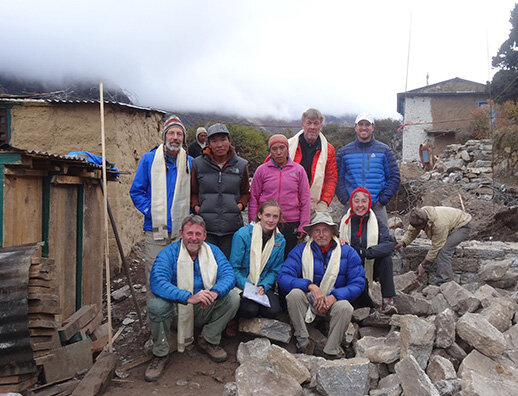 The One Sherpa Home team with Mingma and his wife in Phortse. Clark Parrish, left, and Dave Mauro, front left. Courtesy photo
The One Sherpa Home team with Mingma and his wife in Phortse. Clark Parrish, left, and Dave Mauro, front left. Courtesy photoDave Mauro and his hired guide Mingma Chhring Sherpa summited Mt. Everest on May 20, 2013 at 3:43 a.m. making Mauro the 65th American to climb the Seven Summits, the tallest peaks on each continent. Mingma notched his 11th summit of Mt. Everest that morning. Two and half years later, Dave and other Bellingham locals would raise the money and travel to the Nepalese village of Phortse to rebuild Mingma’s home following the 2015 Nepal earthquake.
Mountain climbing
In 2013, Dave climbed Everest through elite guide service International Mountain Guides (IMG) and was paired to work closely with Mingma during his climb. The two spent two months together on the mountain, Mingma speaking in broken English and both risking their lives to reach the summit.
Dave said they built a connection when they first started climbing together on the Khumbu Icefall. The Khumbu Icefall is the first significant obstacle when climbing Everest from the south side and considered one of the most dangerous. It’s a 3,000-foot section of ice broken off from the Khumbu Glacier that moves up to six feet per day, creating crevasses hundreds of feet deep and up to 50 feet wide. Climbers walk across and up ladders as they navigate their way through. Most pass through the icefall multiple times as they acclimate to the elevation. Dave and Mingma were roped to each other. If one of them fell, the other either stopped them or they would fall together.
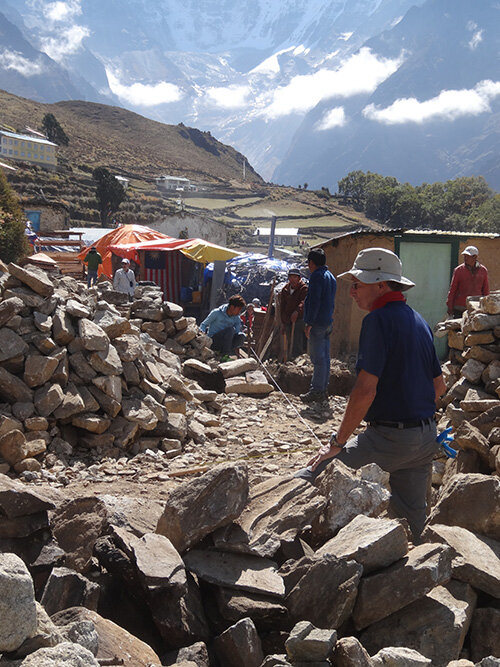 Members of the group and Sherpa clear the site for construction. Dave Mauro photo
Members of the group and Sherpa clear the site for construction. Dave Mauro photo“When you go through something as terrifying as the Khumbu Icefall and you’re roped to another person, you immediately start to develop a close relationship,” Dave said.
Several times they would hear an avalanche break loose above them, and they would scramble for cover. The avalanche would storm past them as they huddled together behind a serac. Dave said days during the climb are riddled with moments like these that could be life altering. Moments that he said you want to take time to acknowledge although you must press on. The more they shared these moments he said the closer they bonded.
Mingma and Dave
Mingma is a Sherpa from the village of Phortse in Khumbu, Nepal, where many Sherpas who guide on Everest come from. Sherpas are an Indigenous group of eastern Tibet. Mingma studied at the Tengboche Monasetry to become a monk until he couldn’t afford to pay the $1,000 per year tuition, so he returned to Phortse. IMG hired him as a load-carrying Sherpa shortly after. He became a guiding Sherpa a year later after attending the Khumbu Climbing School and summited Everest for the first time in 2002.
Dave’s father left when he was a kid, and he grew up in poverty. He graduated from the University of Washington. He’s a certified financial planner who has worked for large investment companies. He recently opened his own investment firm. Dave lost his only brother and got divorced from his wife, with whom he had two — now grown — kids, shortly before he started climbing mountains. Dave shares more of his story and the rest of his journey to climb atop the Seven Summits in his book, “The Altitude Journals.”
One Sherpa home
On April 25, 2015 at 6:11 a.m., a 7.8 magnitude earthquake along the Main Himalayan Thrust fault killed nearly 9,000 people and injured nearly 22,000. The Gorkha earthquake and its aftershocks leveled buildings and homes in Nepal’s capital Kathmandu. Hundreds of thousands of Nepalese people were left homeless with entire villages flattened. It triggered an avalanche on Everest that killed 22 people, the mountain’s deadliest incident on record.
Mingma was in Tibet at the time, guiding in the northern Himalayas. His sons were attending boarding school in Kathmandu and his wife was at home in Phortse. Dave said initially Mingma couldn’t get a hold of them or any reliable information as to the extent of the damage. The second day after the earthquake, he called Dave asking for help. “I don’t know what to do. Can you help me?” Dave said were his words.
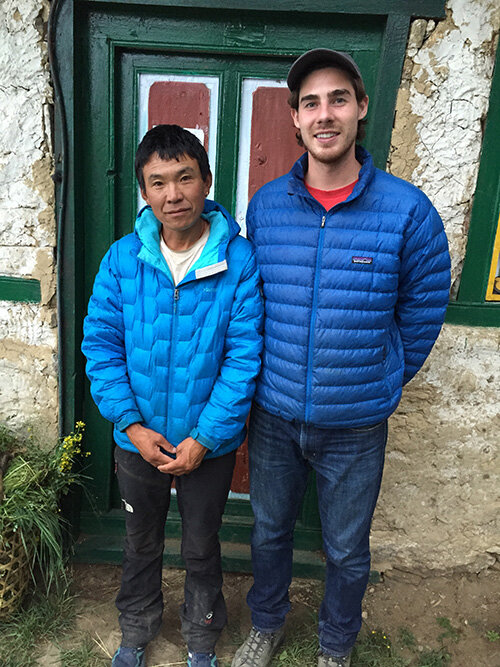 Mingma Chhring Sherpa, left, and architect Trevor Mauro. Courtesy photo
Mingma Chhring Sherpa, left, and architect Trevor Mauro. Courtesy photoDave called some of his contacts in Kathmandu and Khumbu, and eventually Mingma’s sons were found in a refugee camp near the Kathmandu airport. Mingma also learned his wife was alive as well, but his home was destroyed. As Mingma made his way back to Phortse, Dave said his efforts to help Mingma focused on his home.
“Sending a big sum of money into a disaster zone is not always a great idea,” Dave said. “It's going to pass through hands and you just don’t know how much of it’s going to get where it’s supposed to go. There are people who take advantage at times like that and they’ll represent themselves as contractors and demand a big front deposit, and disappear.”
By process of elimination and a need for certainty, Dave said he decided to rebuild the home. He formed a nonprofit organization and GoFundMe called “One Sherpa Home” and began fundraising. Dave said he called it “One Sherpa Home” because that was what they planned to build: One Sherpa home. After that, he would close the organization.
The plan was to travel to Nepal with other volunteers from Bellingham and start the construction process. Dave’s eldest son Trevor Mauro had just graduated from the Illinois Institute of Technology in Chicago with a bachelor’s degree in architecture. Trevor was sent to Nepal for two weeks in June 2015 to conduct a site survey.
Trevor said he spent a week in Kathmandu before flying solo to Lukla with a large duffle bag of supplies. The airline sent an attractive female flight attendant who didn't speak English on the short flight over. While nice to have company, Trevor, who is gay, said it was entirely unnecessary. After arriving in Lukla, Mingma met him at the airport and they made the three-day trek to Phortse together. Trevor lived with Mingma and his wife for a week under a tarp while he assessed the damage and materials available and drafted technical drawings. Trevor said his initial instinct was to design a modern home as he was trained.
A Sherpa’s home has cultural significance, so Mingma had a few requests. It had to be two stories, as all elder statesmen in Sherpa culture must have two-story homes. It also had to have traditional Sherpa windows, a temple, dry storage and space for livestock to come in out of the weather. Trevor said understanding the culture of the village and meeting Mingma’s cultural needs for the design was the biggest lesson learned, adding the cultural needs are easy to overlook as a young person. Trevor settled on a traditional design, with modern features.
“We were committed to respecting that culture at every turn of the road,” Dave said. “I think the design did a marvelous job of that.”
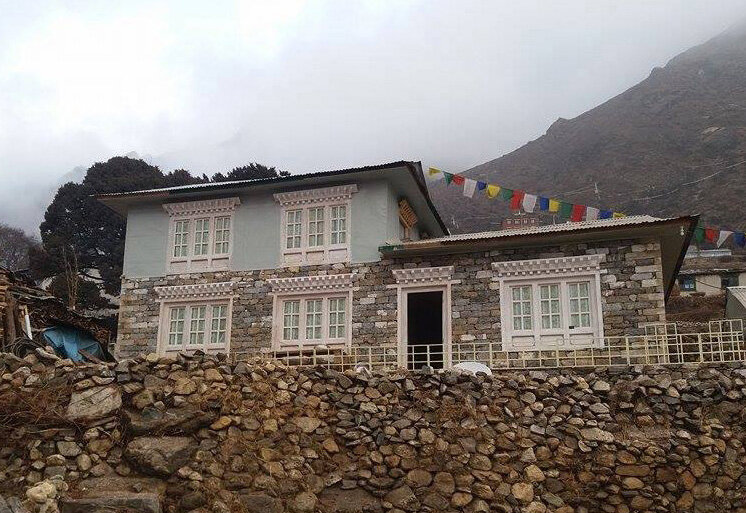 Mingma Chhring Sherpa's finished home in Phortse, Nepal. Mingma Chhring Sherpa photo
Mingma Chhring Sherpa's finished home in Phortse, Nepal. Mingma Chhring Sherpa photoStructural improvements included using a gabion rock structure as the foundation and building the home parallel with the hillside. Concrete is not available in Khumbu. All materials are gathered locally or flown or trekked in. The gabion foundation mimicked a concrete foundation, with caged rock extending down into the ground.
Trevor returned to Washington with a design drafted and handed it over to an engineer who worked pro bono. Dave put together a group of seven volunteers from the Bellingham area. The group traveled over in October 2015 with $18,000 raised to go toward building the home. All members of the group paid their own way. Dave wired the money to himself in Kathmandu and used it to buy tools and supplies. They hired Sherpa and a herd of yak to carry the supplies from Lukla to Phortse.
Phortse sits at nearly 13,000 feet. The trek from the airport in Lukla takes around three days. Bellingham physician Dr. Clark Parrish, who had trekked in the Himalayans three times before, joined the group and attended to any minor injuries while observing their acclimatization. Parrish said everyone faired just fine.
When the group arrived in Phortse, they all helped lay the foundation, which consisted of gathering and placing rocks in the gabions and reinforcing them with rebar. This they believed would allow the structure to flex in future earthquakes and yet not collapse. Local Sherpas were hired to help with laying the foundation. Dave said part of their goal was to teach the building technique to the Sherpas so they could use it in rebuilding their own homes. The group was in Phortse for 11 days and camped while working on the home. They nearly completed the foundation in that time. They also took a tour of Phortse and visited the Khumbu Climbing Center.
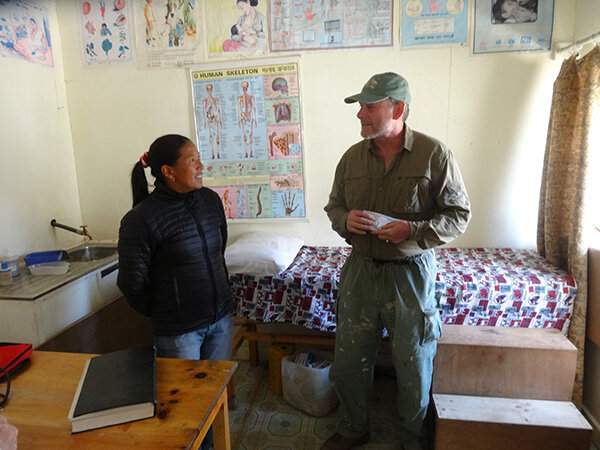 Dave Mauro, right, gifts spare funds to a local clinic. Courtesy photo
Dave Mauro, right, gifts spare funds to a local clinic. Courtesy photoThe tools they had brought in were left in the village as a mini cooperative for anyone to use. Dave then left about $8,000 with a local Sherpa builder to finish the home. About $5,000 was left over. Dave said he left it with the clinic and school in Phortse and a neighboring village’s clinic and school.
“I think most people who have been over there to go trekking or climbing realize none of us would have been able to do what we had without the help of the Sherpas,” Parrish said.
Mingma and his family moved into their new home in January 2016.
Parrish returned to Khumbu to trek in 2018. He visited Phortse and saw Mingma’s completed home occupied.
Dave and Mingma stay in touch.
To Watch:
Netflix’s docuseries “Aftershock: Everest and the Nepal Earthquake” captures survivors firsthand accounts of the 2015 Nepal earthquake along with actual footage from the disaster.